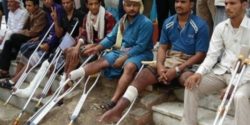The American, British, and French Cluster bombs are still threatening the lives of thousands of Yemenis, although the Executive Center for Mine Action in the capital, Sana’a, managed to destroy about 1.8 million cluster bombs from the remnants of the Saudi-Emirati coalition raids during the past years.
The number of victims of these internationally-prohibited bombs is increasing daily, not only among civilians but also among the many demining workers who are constantly losing their lives.
In this context, official statistics indicate that this type of lethal bomb has killed and wounded 3,810 civilians during the past years of the war, including women and children.
According to the statistics, the number of people killed by cluster bombs dropped by Saudi and Emirati aircraft near residential neighborhoods in the capital, Sana’a, and the provinces of Sanaa, Hajjah, Hodeida, Jawf, Amran, Bayda, and Marib, has reached 1,019 civilian deaths, including more than 115 children and 39 women, while the number of wounded amounted to 2,822 civilians, including 241 children and 76 women.
The Executive Center for Mine Action also reported earlier this year that cluster bombs destroyed and damaged about 809 farms and tons of crops and 547 grazing areas, due to their destructive effects.
Over the past years of the war, the center surveyed large areas that were targeted by the coalition warplanes, some of which witnessed armed confrontations between the parties to the conflict, and the results were shocking, as the total number of mines and remnants of war during the years 2015 to 2021 amounted to more than 862,676, including mines and bombs that fall within the framework of booby traps, various missiles, missile heads, and aircraft bombs.
Cluster bombs and remnants of war have become a societal problem in Yemen
Director of the Executive Center for Mine Action, Brigadier General Ali Sofra, confirmed to the Lebanese “Al-Akhbar” newspaper that “cluster bombs and the remnants of the war in Yemen have become a societal problem,” considering that “clearing them and getting rid of them is also a societal entitlement.”

He added that “the Saudi coalition continued to use internationally-prohibited weapons, ignoring international laws, and threatening the lives of thousands of innocent civilians.”
Safra pointed out that “the national program for mine action that he runs is “a humanitarian program that serves all segments of Yemeni society, regardless of sectarian and political affiliations.”
He described the Saudi-Emirati coalition’s ban on entry of devices, equipment, and basic work requirements such as explosives detection devices on the pretext that they are military tools as “an increase in crime” that reflects “the desire of the coalition countries that are still using cluster bombs to this day.”
Effects of Saudi-led coalition cluster bombs in Yemen
The center’s monitoring and documentation department reported that the center monitored the coalition’s use of about 15 types of cluster bombs, noting that there are “remnants of cluster bombs in the form of children’s toys, such as the remnants of the American-made cluster bomb “CBU_58A/B”, whose victims are many children, in addition to the presence of French and Brazilian bombs that were widely used by the Saudi coalition.

The department warned that “the danger of these bombs is very great for the lives of thousands of Yemenis, and if they remain unremoved, it is expected that their danger will worsen if they decompose in the soil, as they are toxic and may contaminate groundwater wells.”
“The process of scanning and removing them requires raising the level of the center’s capabilities,” the department added, calling on the United Nations to play its role in enhancing these capabilities.
Coalition buys unknown-source cluster bombs to escape legal liabilities
During the past few months, the center intensified its efforts in the field of demining in Hodeida province, specifically in the areas from which the pro-Emirati forces withdrew late last year. Because the center’s workers lacked the required personal protective equipment, many of them were killed.

Late last month, the coalition warplanes targeted the place where mines and cluster bombs were collected in the Bani Matar district, west of the capital Sana’a, with eight raids, using the American-made bomb “GUB_31”, which is one of the most dangerous offensive bombs that can penetrate up to four meters of reinforced concrete, and its temperature when it explodes reaches between 2,800 and 3,500 degrees Celsius.
According to experts, the use of this type of bomb may have played a role in the increase in cancerous diseases, birth defects, and stillbirths among the population whose areas were bombed with it, and these phenomena have recorded remarkable growth over the past two years.


